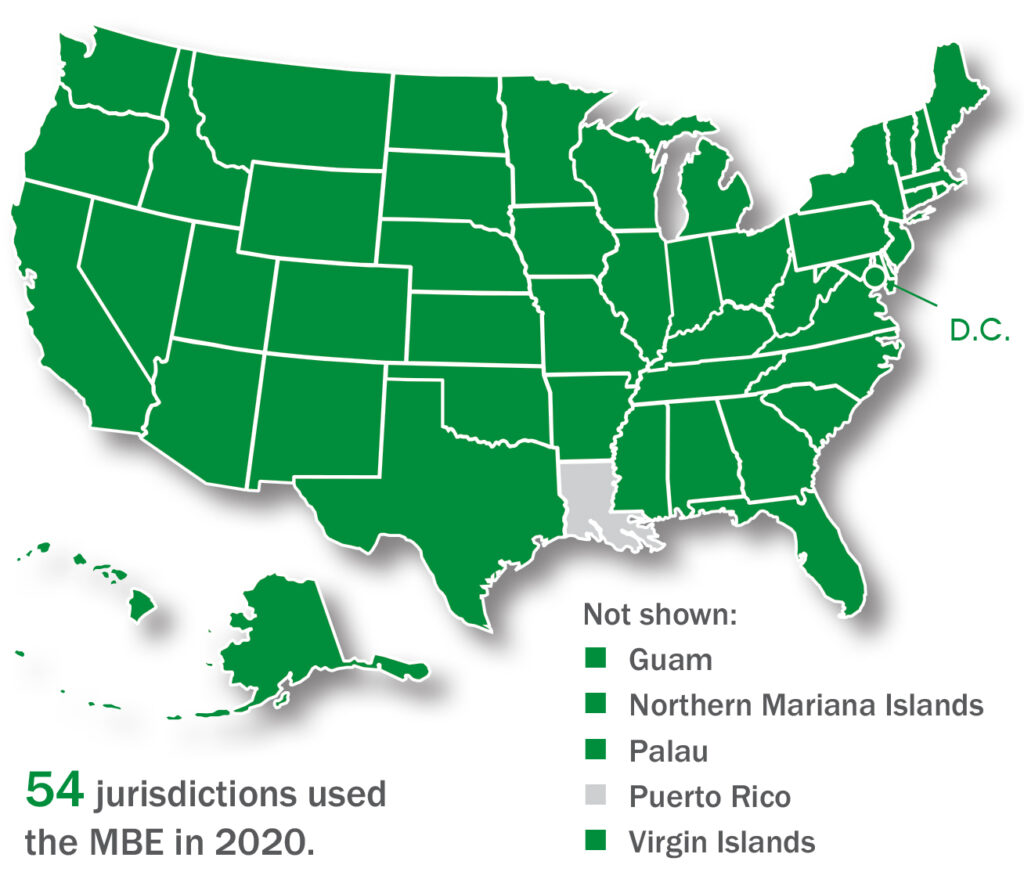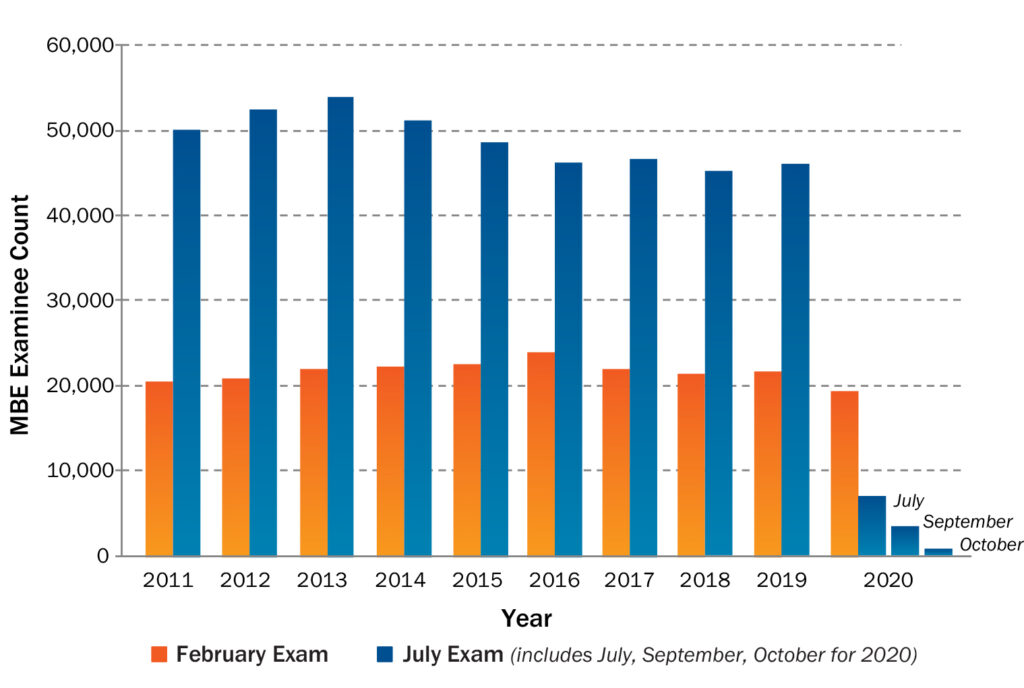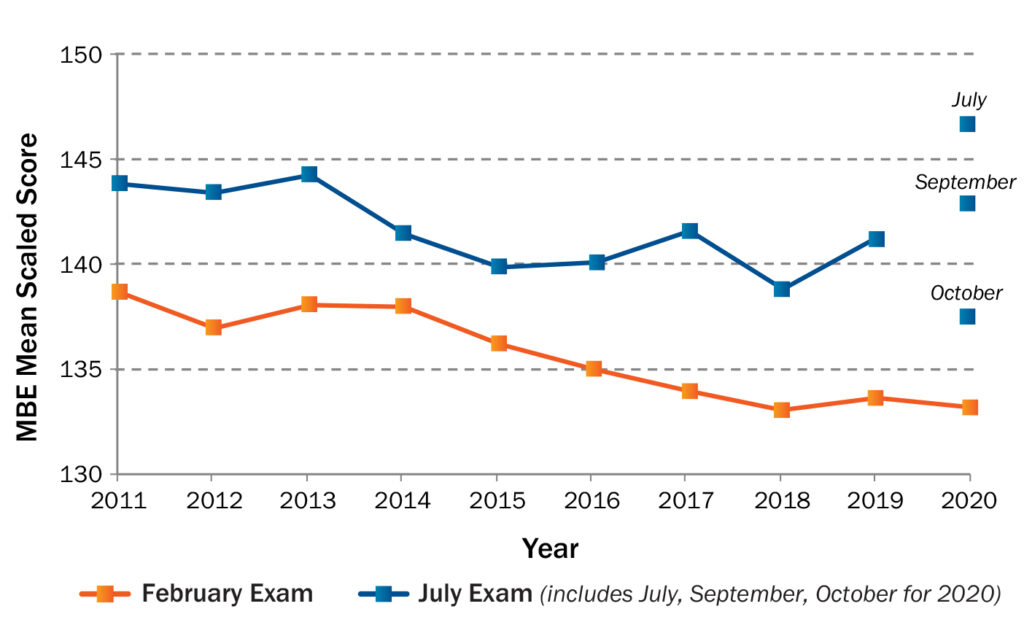The Multistate Bar Examination (MBE)
The National Conference of Bar Examiners has produced the Multistate Bar Examination (MBE) since 1972.
The MBE consists of 200 multiple-choice questions in the following areas: Civil Procedure, Constitutional Law, Contracts, Criminal Law and Procedure, Evidence, Real Property, and Torts. The purpose of the MBE is to assess the extent to which an examinee can apply fundamental legal principles and legal reasoning to analyze given fact patterns.
Both a raw score and a scaled score are computed for each examinee. A raw score is the number of questions answered correctly. Raw scores from different administrations of the MBE are not comparable, primarily due to differences in the difficulty of the questions from one administration to the next. The MBE, like virtually all high-stakes exams, is equated. Equating is a statistical process that adjusts for variations in the difficulty of the questions, producing scaled scores that represent the same level of performance across all MBE administrations. For instance, if the questions appearing on the July MBE were more difficult than those appearing on the February MBE, then the scaled scores for the July MBE would be adjusted upward to account for this difference. These adjustments ensure that no examinee is unfairly penalized or rewarded for taking a more or less difficult exam. Each jurisdiction determines its own policy with regard to the relative weight given to the MBE and other scores. (Jurisdictions that administer the Uniform Bar Examination [UBE] weight the MBE component 50%.)
Jurisdictions Using the MBE in 2020

NOTE: Delaware and Palau, both of which use the MBE but canceled their exams in 2020 due to the COVID-19 pandemic, are included in this count of 54 jurisdictions.
2020 MBE National Summary Statistics (Based on Scaled Scores)
Note: The values in this chart reflect valid scores available electronically as of 3/15/2021.
| February | July | September | October | 2020 Total | |
|---|---|---|---|---|---|
| Number of Examinees | 19,122 | 5,678 | 1,811 | 417 | 27,028 |
| Mean Scaled Score | 132.6 | 146.1 | 142.7 | 137.2 | 136.2 |
| Standard Deviation | 15.6 | 15.8 | 15.0 | 17.8 | 16.7 |
| Maximum | 183.9 | 185.6 | 181.6 | 178.9 | 185.6 |
| Minimum | 46.3 | 79.4 | 77.4 | 78.7 | 46.3 |
| Median | 132.7 | 147.3 | 143.0 | 137.5 | 136.1 |
2020 MBE National Score Distributions
Note: The values in this chart reflect valid scores available electronically as of 3/15/2021.These data represent scaled scores in increments of 5, with the exception of 85, which includes all examinees below that score. For example, the percentage reported for 135 includes examinees whose MBE scaled scores were between 130.5 and 135.4. Percentages may not sum to 100% due to rounding.
| ID | MBE Scaled Score | February (Mean = 132.6) — Percentage of Examinees | July (Mean = 146.1) — Percentage of Examinees | September (Mean = 142.7) — Percentage of Examinees | October (Mean = 137.2) — Percentage of Examinees |
|---|---|---|---|---|---|
| 1 | 85 | 0.1 | 0.0 | 0.1 | 0.2 |
| 2 | 90 | 0.2 | 0.1 | 0.0 | 0.0 |
| 3 | 95 | 0.6 | 0.1 | 0.0 | 0.0 |
| 4 | 100 | 1.1 | 0.2 | 0.1 | 0.7 |
| 5 | 105 | 2.0 | 0.5 | 0.5 | 1.9 |
| 6 | 110 | 3.9 | 1.0 | 1.0 | 4.8 |
| 7 | 115 | 5.2 | 1.8 | 2.4 | 5.0 |
| 8 | 120 | 8.3 | 2.8 | 3.6 | 6.5 |
| 9 | 125 | 11.1 | 4.5 | 5.7 | 8.4 |
| 10 | 130 | 11.3 | 5.7 | 8.9 | 8.9 |
| 11 | 135 | 14.3 | 7.5 | 10.0 | 7.7 |
| 12 | 140 | 11.6 | 10.3 | 11.4 | 11.3 |
| 13 | 145 | 9.7 | 11.0 | 12.0 | 11.0 |
| 14 | 150 | 8.0 | 12.1 | 11.3 | 7.9 |
| 15 | 155 | 4.8 | 12.8 | 10.4 | 7.7 |
| 16 | 160 | 3.9 | 10.2 | 9.9 | 7.0 |
| 17 | 165 | 1.9 | 9.0 | 6.7 | 5.5 |
| 18 | 170 | 1.3 | 6.2 | 3.4 | 3.4 |
| 19 | 175 | 0.5 | 3.0 | 2.0 | 1.4 |
| 20 | 180 | 0.1 | 1.1 | 0.4 | 0.7 |
| 21 | 185 | 0.0 | 0.2 | 0.1 | 0.0 |
| 22 | 190 | 0.0 | 0.0 | 0.0 | 0.0 |
MBE National Examinee Counts, 2011–2020
Note: The values in this chart reflect valid scores available electronically as of 3/15/2021.
| ID | Year | February (Number of Examinees) | July (Number of Examinees) | Year Total (Number of Examinees) |
|---|---|---|---|---|
| 1 | 2011 | 20,369 | 49,933 | 70,302 |
| 2 | 2012 | 20,695 | 52,337 | 73,032 |
| 3 | 2013 | 21,578 | 53,706 | 75,284 |
| 4 | 2014 | 22,083 | 51,005 | 73,088 |
| 5 | 2015 | 22,396 | 48,384 | 70,780 |
| 6 | 2016 | 23,324 | 46,518 | 69,842 |
| 7 | 2017 | 22,269 | 46,627 | 68,896 |
| 8 | 2018 | 21,111 | 45,274 | 66,385 |
| 9 | 2019 | 21,316 | 45,334 | 66,650 |
| 10 | 2020 | 19,122 | 5,678 July
1,811 September 417 October |
27,028 |

MBE National Mean Scaled Scores, 2011–2020
Note: The values in this chart reflect valid scores available electronically as of 3/15/2021.
| ID | Year | February (Mean Scaled Scores) | July (Mean Scaled Scores) | Year Total (Mean Scaled Scores) |
|---|---|---|---|---|
| 1 | 2011 | 138.6 | 143.8 | 142.3 |
| 2 | 2012 | 137.0 | 143.4 | 141.6 |
| 3 | 2013 | 138.0 | 144.3 | 142.5 |
| 4 | 2014 | 138.0 | 141.5 | 140.4 |
| 5 | 2015 | 136.2 | 139.9 | 138.7 |
| 6 | 2016 | 135.0 | 140.3 | 138.5 |
| 7 | 2017 | 134.1 | 141.7 | 139.2 |
| 8 | 2018 | 132.8 | 139.5 | 137.4 |
| 9 | 2019 | 134.0 | 141.1 | 138.8 |
| 10 | 2020 | 132.6 | 146.1 July
142.7 September 137.2 October |
136.2 |







